
The Yogic Kitchen
I want you to go slowly with this, go gently and remain flexible. I am introducing you to Ayurveda to improve your life, not add another stress. It’s all about balance and moderation, so cliché but so true when it comes to wellness.
To get started, first you need to figure out which doshas form your constitution, and then take a look if you are in balance or out of balance, which is perhaps what brought you to this book. All of that’s in the next section. You will learn about the various characteristics of each dosha, then how to balance your constitution, followed by a little about the Ayurvedic approach to health, including the perfect daily routine and which foods to embrace and which to avoid if you are feeling out of whack. Of course, the bulk of this book is recipes, so once you know which dosha you are predominantly and that it is in balance, you could simply skip to that section and eat from there, confident that you are doing yourself some good.
There are Vata recipes that feature warming foods for autumn and early winter or for Vata types who need to reduce cooling foods, followed by Pitta recipes to cool you down in summer, and finally Kapha recipes for late winter and spring that contain astringent foods to help dry up the season’s colds. These recipes will help you harmonise your doshas and help you gain a feeling of balance.
For those of you who need to know more, the endmatter (pages 228–245) provides even more information in the form of pantry information, food charts and other useful references.
Okay, hope that’s all clear. Let’s get into it!
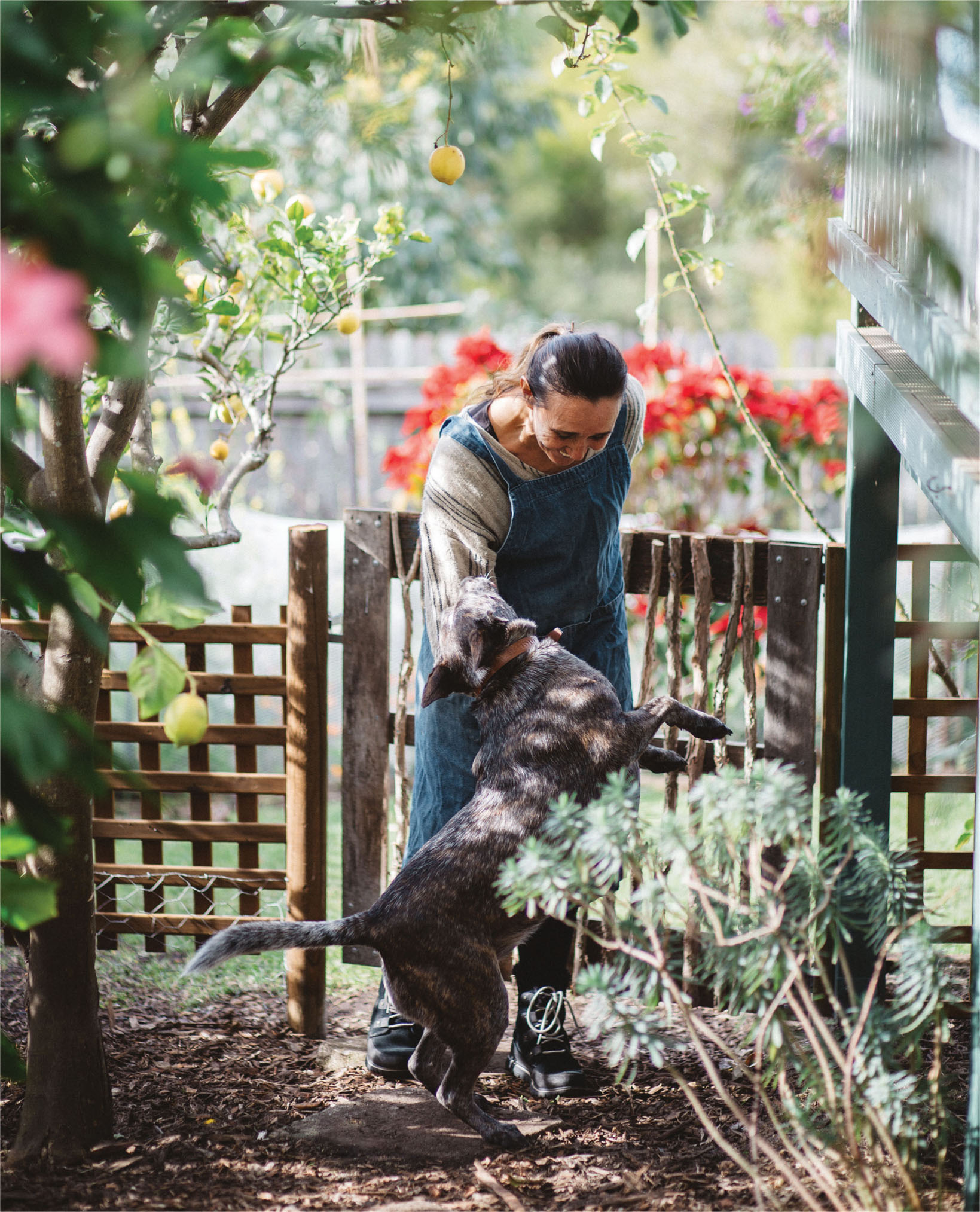
Which dosha are you?
READING YOUR CHART AND DISCOVERING YOUR DOSHA
On the following pages are two charts that will help you figure out the particular mix of doshas that comprise your constitution. You may discover that you have some of the characteristics of all three doshas; this is not uncommon. But you will probably have one dominant dosha (Vata, Pitta or Kapha), then another dosha that is slightly less obvious, and so you would be, say, Vata Pitta, Pitta Kapha or Vata Kapha.
For example, I am a Pitta Vata. I have far stronger Pitta tendencies than I do Vata so I focus on managing my Pitta, but I do have to be aware of my Vata when I travel and in autumn and early winter, the Vata season (more on this later). You may find you are a Pitta Kapha, for example, and so you would focus on balancing Pitta generally but also managing Kapha tendencies in the Kapha season of late winter and spring or if you have a cold or cough, and you may need to manage the Kapha if you find you are gaining some excess weight in later years.
Be sure to look at both the physical and emotional/psychological/lifestyle/environmental characteristics of each dosha. A person may be physically a Kapha type but emotionally a Vata; this person would then be considered a Kapha Vata.
Just watch the tendency to make sweeping statements and generalisations about your doshas: there are a lot of factors and elements at play here. And what may appear to be someone’s dosha may be a big imbalance that is demanding their attention. The world outside of us and the world inside us are ever-changing and so are we.
WHAT DOES TRIDOSHIC MEAN?
If, when you fill out the charts, you find you have an even amount of characteristics from Vata, Pitta and Kapha, you are described as being Tridoshic. This means you have a fairly balanced constitution but will still need to be aware of each dosha in its season. Ayurveda recommends tridoshic people follow a Vata diet usually because Vata is the dosha that goes out of balance first and the other doshas then follow. To obtain a more accurate and individual dosha reading and diagnosis, you may wish to seek out a consultation with an Ayurvedic practitioner.
Dosha evaluation charts
Go through the charts and tick the boxes, then add up the ticks. The one you have the most ticks under is your dominant dosha, the next your secondary dosha.
Normally we would suggest completing a dosha chart twice: the first time to establish your constitution (prakruti) and the second time to establish any imbalance (vikruti). Understanding your constitution will give you valuable insight into your tendencies; knowing your tendencies will help you manage your health and go a long way in helping you to create a balanced life for yourself. Each of us is made up of varying amounts of Vata, Pitta and Kapha energy. Vata provides us with movement and expression, Pitta governs our metabolic action and Kapha builds our tissues.
The first time you go through the chart, think about your body shape, emotional responses and personality up to about 18 years of age. If you can discuss this with your parents, you will often find they are able to share some valuable information with you about your behaviour in your younger years and they may have a much clearer memory of your size and shape.
The second time you fill out the chart, approach it from how you are now. Watch out for changes in weight, mood etc. to your formative years. Be honest and present. This can be a very helpful tool if used properly and you cannot get it wrong, as we are just trying to establish where your body is not functioning as it should.
If you complete the chart twice and your prakruti and vikruti are the same, then this is a good thing as it shows that your body is in a state of balance. But remember, the body is always in a state of flux, sensitive to outside influences and always trying to communicate any imbalance to you.
In Ayurveda we treat the imbalance to bring the body back to a state of health. Regardless of your constitution, you can experience an imbalance in any of the doshas. Imbalance is created from the external environment: not just the weather but any outside influences – food, habits, home environment.
A good way of determining your prakruti is by thinking about the things about you that never change. Body shape can fluctuate and cause some confusion but things like your basic personality tend to stay the same throughout your life.
Experience is simply the name we give our mistakes.
–Oscar Wilde
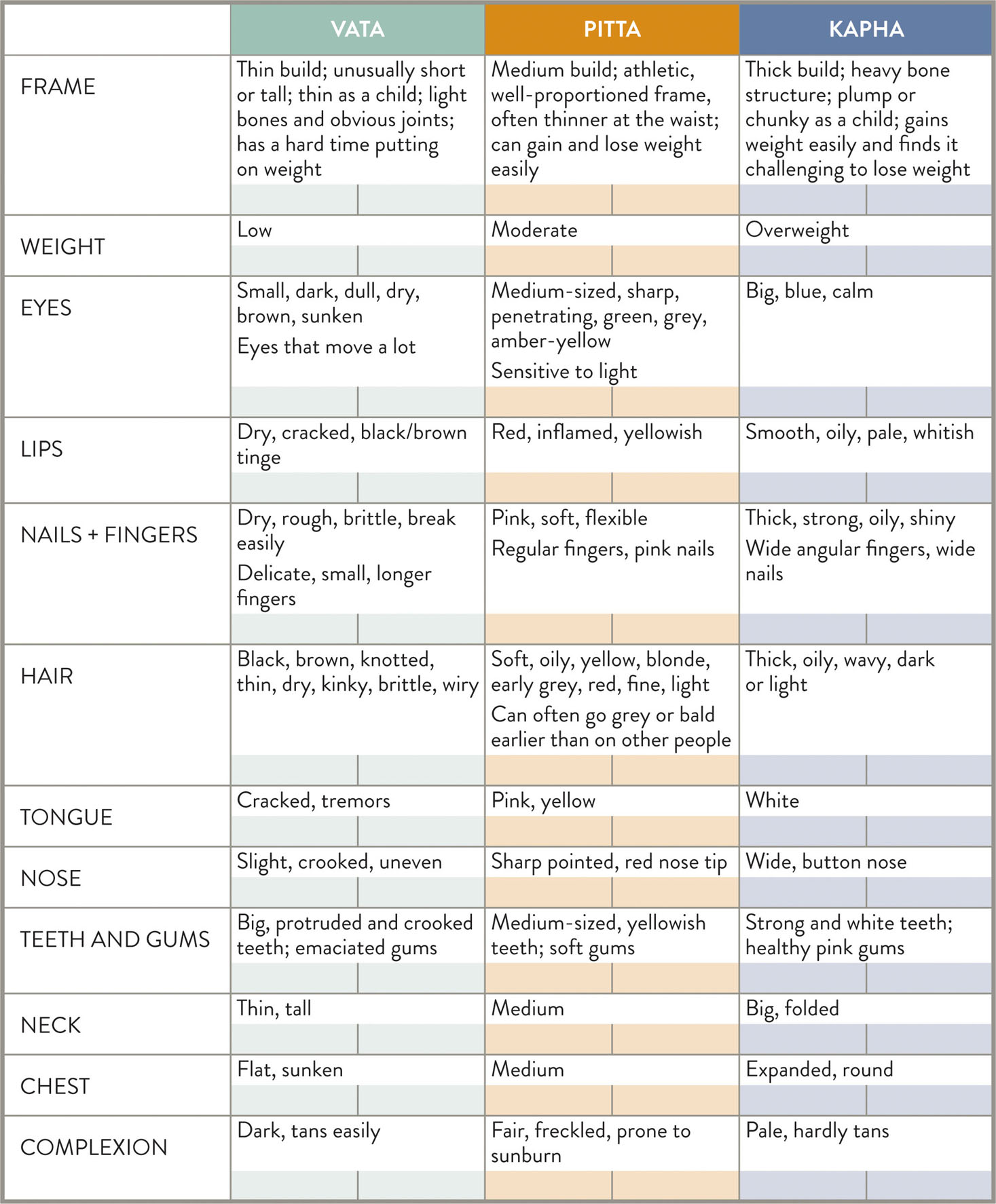
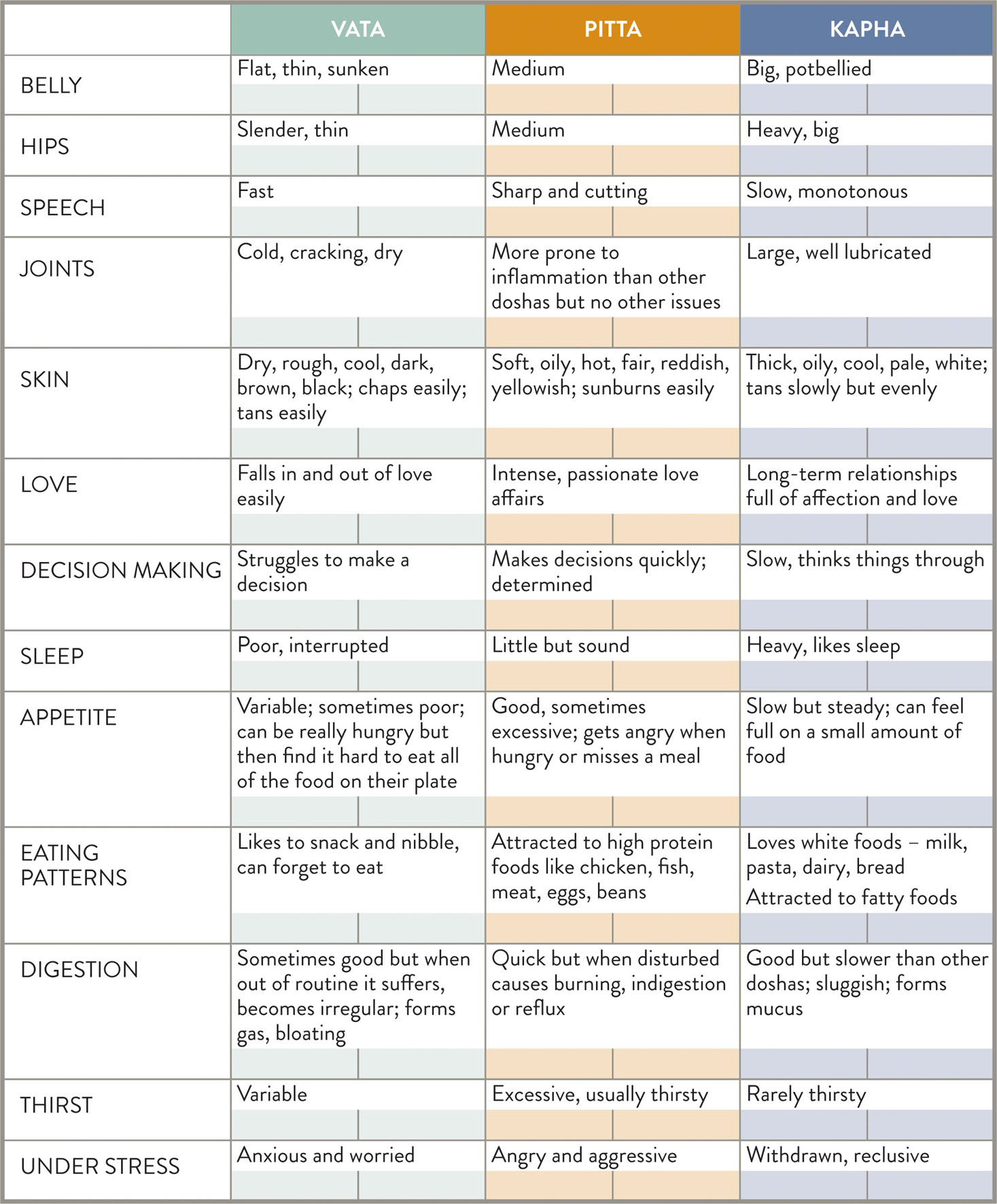
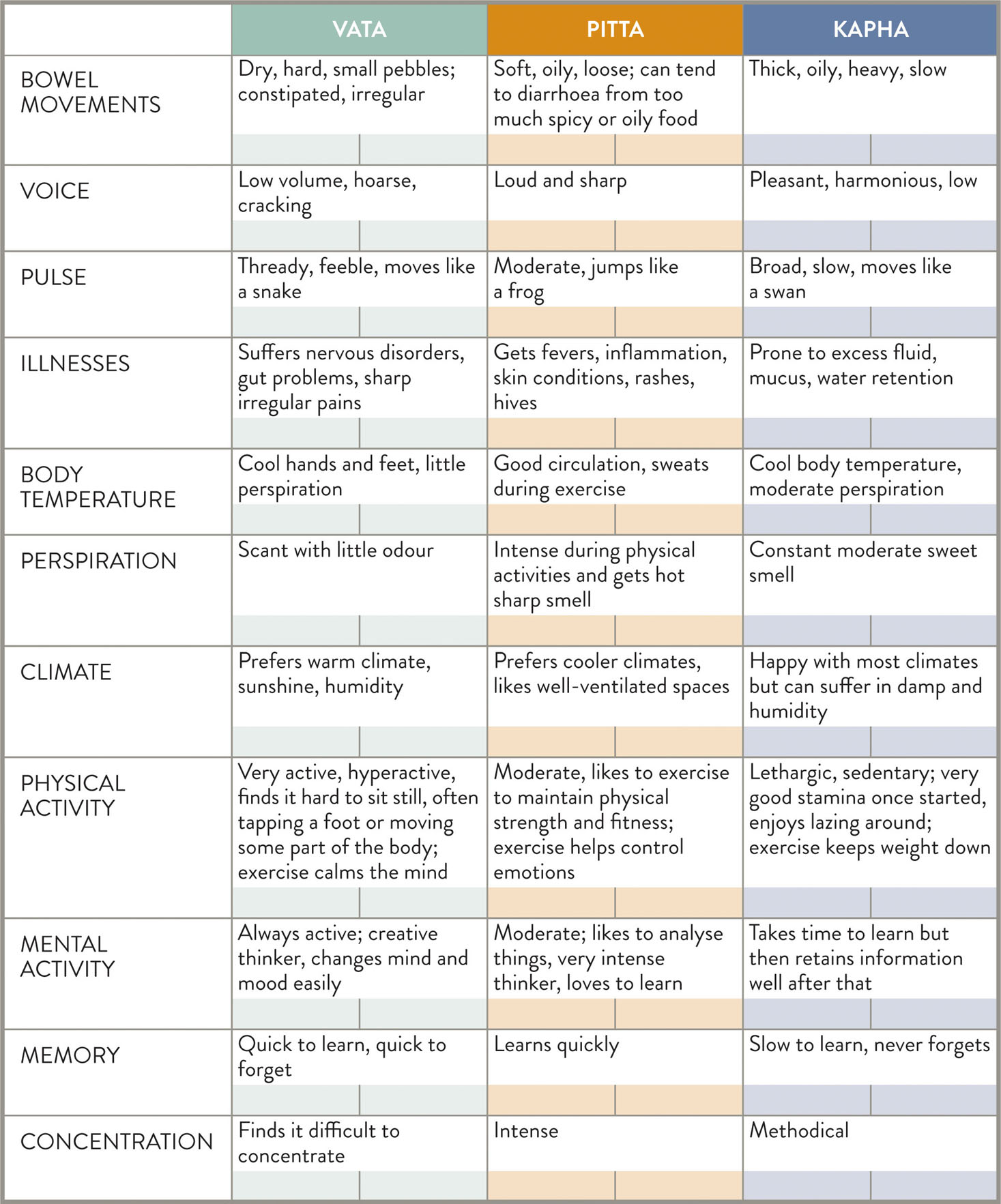
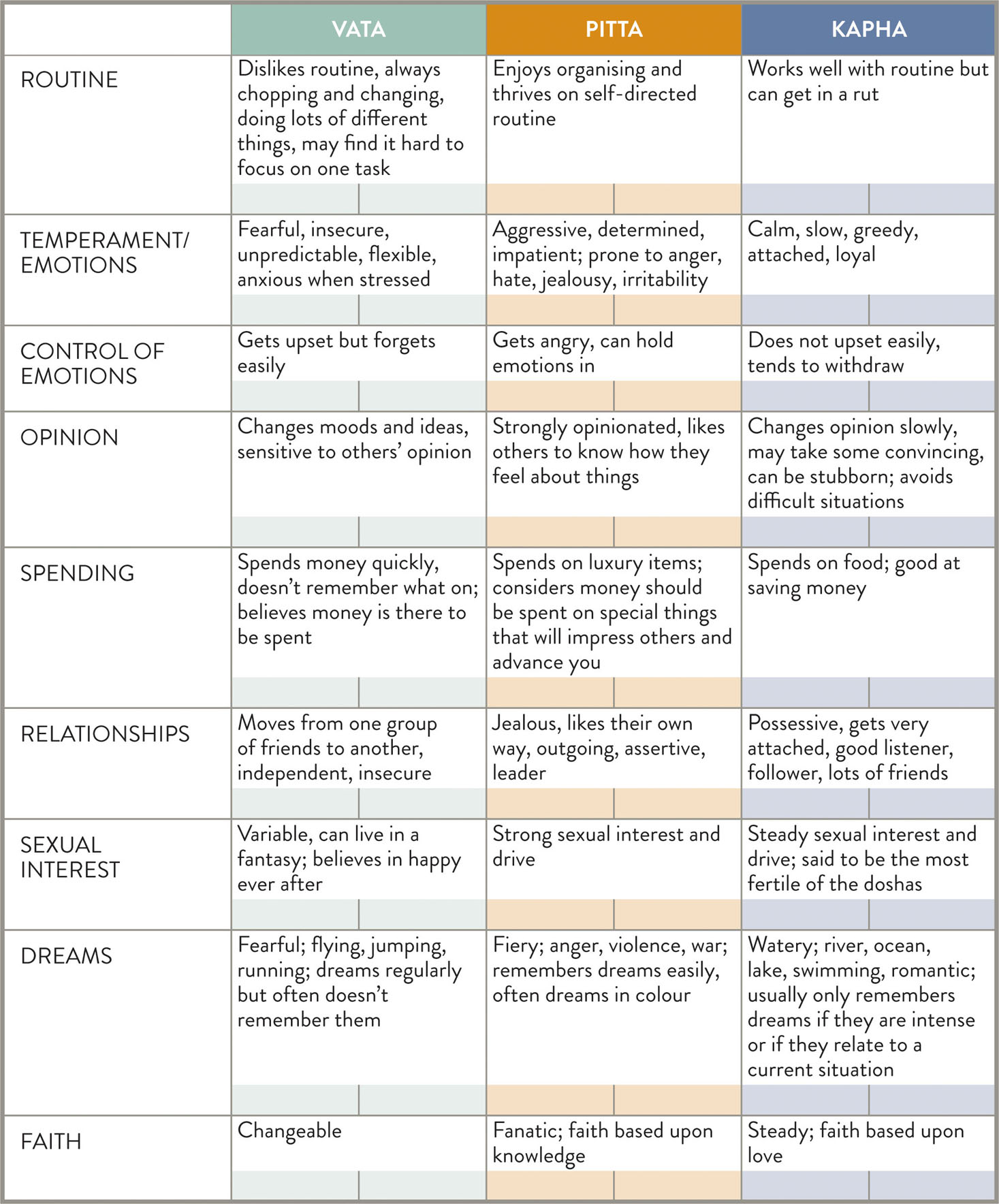
The doshas
THE VATA INDIVIDUAL
Vatas are the skinny tall folks, who can struggle to put on weight no matter what they eat or how much they eat. Vata rules movement, creativity and communication in the body, so it is easy to see why Vata types find it hard to sit still, love a chat and may have wild imaginations. You may notice them chattering away to themselves or telling a long-winded story. Because they have so much going on inside their heads they find it difficult to listen, their eyes may dart about as you talk to them and they are very easily distracted. Vata types may be more fearful and anxious of everyday things than others and tend to be light sleepers. Sensitive Vata souls suffer without a routine to stabilise and ground the air and space in them.
Quick to learn but also quick to forget, they may be more interested in the arts and creative activities than reading, writing and arithmetic. Without a routine, they may appear scattered and a bit all over the shop. Vatas often find themselves surrounded by mess, which can be a direct reflection of their state of mind. Vatas tend to overthink everything and find it difficult to make decisions. Vatas suffer under stress. They make friends quickly and change friends often, and can have difficulty forming close relationships. This is also reflected in their interests. Intensely interested in one thing momentarily and then onto the next thing before you know it. The qualities of the dosha are light and mobile so this is natural behaviour for their constitution.
Vata types are incredibly soft and intuitive and are greatly affected by the moods of those around them; when things get overwhelming for them they may just drift off into their minds where things are more comfortable for them. They are insatiable daydreamers. Anxiety and constipation can be a symptom of Vata imbalance. It is important that these types stay warm, slow down and create a routine for themselves to help balance the air and space in their dosha.
The qualities of Vata are like the wind – quick, light, dry, cold, subtle, mobile and rough. Vatas will often have dry cracked skin, hair and lips. They feel the cold and will often complain of cold hands and feet. They love the sun and their holiday of choice will most likely be a beach destination. They are disturbed by the wind and excess travel. They are drawn to crispy, crunchy foods but these foods will quickly send them out of balance. They have joints that crack and their bodies are the most fragile and sensitive of the three doshas because of the dry, light qualities of their constitution. The mobile quality may allow them to be efficient multi-taskers but it is essential they get plenty of rest to help them deal with the constant movement as they are delicate types. Vata types may also have a tendency to swing drastically in terms of weight, and flip from being underweight to overweight quickly. Things are everchanging with Vata individuals, be it in their homelife, workplace, relationships or physical body.
Their subtle nature may mean they are drawn to the spiritual and they have a natural tendency to seek out more esoteric experiences than the other two doshas. Vata types are most comfortable in nature by a running stream, listening to birds and gazing up at the stars. Vatas can be shy, insecure and awkward in social situations and one of their biggest challenges is to come to a place of self-acceptance. This fast paced modern world is often confronting to these Vatas, who may worry and struggle to keep up and fit in.
For more information on Vata out of balance, see page 24.
THE PITTA INDIVIDUAL
Pitta types love to be the centre of attention. Ruled by the elements of fire and water, they are born to shine and it’s hard to mistake when a Pitta enters a room. These types like to be in control and are easily annoyed if made to follow rules and regulations. Pitta children are happy to figure things out for themselves and like to receive praise and recognition when they are successful. Blessed with strong athletic bodies, Pittas are driven, competitive individuals who play to win. Anger is their go-to emotion and if they don’t get what they want, they can make things uncomfortable for all around them.
Pittas are fiery types whose qualities are hot, oily, sharp, light, spreading and liquid. The oily nature gives Pitta types lovely moist soft skin, though it can overheat easily and Pittas will often sweat a lot in hotter weather or suffer from acne, a spreading rash or hives. In life, oiliness means Pittas are very good lubricators when it comes to getting what they want out of life and situations.
They will often use their sharp tongues to ensure you understand their point of view.
Because fire rules transformation and is adept at converting ideas into objects or experiences, Pitta types are great at creating, planning, organising and executing as long as they are the ones running the show. They are energetic, ambitious, aggressive and arrogant about their pursuits, and will often blaze their way down their chosen path with little consideration for those around them. Pittas’ egos need to be kept in check and it is their life lesson to learn to control their self-imposed will and fiery mind and nature. Pitta types can have a tendency to ‘burn out’ if they do not learn to moderate their desires for material possessions. Pittas need to learn patience and to consider others to temper their fires. Pitta types are courageous and make great leaders, as their ability to see a project through to the end is unrivalled by the other doshas.
They have strong, hot digestive systems, a fast metabolism and enormous appetites, and can get very hangry (angry when hungry) if they miss a meal. They may have heat rising in the body if their digestive system is overloaded, complaining of heartburn, ulcers or reflux. Emotionally, it may show up as fiery outbursts, heated conversations or an angry silence. Drawn to intense flavours (chilli, salt, hot’n’spicy) in food and drinks, and intense conversations and experiences, these folks are bored easily and are always on the lookout for the next exciting adventure. Pittas need cooling environments, calm friends and gentle interactions to balance out their natural tendency to overheat, overachieve and overdo. As kids, they often complain they are bored. Pitta rules the eyes and vision, so to calm their forceful nature they will do well painting or surrounding themselves in nature’s beauty. Pitta types care very much about looks. They can become obsessed with their physical body, clothes and like to be seen and acknowledged for their appearance; they like to be seen as ahead of trends, and fashion can become another way they seek attention. Anger, impatience, skin issues, overheating and reflux can be a symptom of Pitta imbalance. It is important that these types learn how to manage heat and ambition. Pitta types often go grey before other types and Pitta men tend to lose hair earlier than the other doshas. For more information on Pitta out of balance, see pages 28–9.
THE KAPHA INDIVIDUAL
Kaphas are caring, maternal, graceful, sensual types. They tend to be focused more on others than on themselves and they can usually be found mothering something or someone. It is said that without Kaphas there would be no home, no children and no family, as Kapha energy ensures the stability and foundation of the home. They have a larger rounder body shape than the other two doshas and tend to put on weight just by looking at food. Ruled by the elements of earth and water, they have a sluggish metabolism and a tendency towards fluid retention. Weight issues are a constant headache for these individuals. Kaphas have thick wavy lustrous hair that is usually blonde or black.
Slow to learn but then they never seem to forget, these people can often be mistaken for being slow or dumb, especially when they are younger. If their teachers don’t have the time or patience to spend extra effort going over things with them, they quickly fall behind at school.
Kaphas are most happy in their own company or being with family. They won’t go out of their way to make friends as they can find friendships exhausting as they always seem to be the ones giving.
Though ruled by earth and water, the qualities of Kapha are most like water – moist, slow, cool, heavy, dense, cloudy, unctuous, stable and viscous. They have soft well-lubricated joints and often their bodies feel cool, soft and slightly moist to touch. They feel the cold and tend to have an aversion to the cooler months. Their heaviness is evident in their body shape but is often more of an issue for these types mentally as it can give them a heavy outlook on life. They are also heavy sleepers who like to sleep for longer periods of time. Kaphas are slow walkers, talkers and thinkers, and won’t be rushed into decisions about anything; Kaphas are always calculating their energy and whether the effort is worth the expenditure. They seem to have a stubborn aversion to change and will often get stuck in unhappy relationships or work situations for long periods.
They are good savers and like to accumulate wealth and have a stable bank balance as this provides them with a strong sense of security. Kaphas love routine and stability but this can work against them if they are in an unhealthy situation. Kaphas can be very attached to the material world; they have a tendency to ground themselves in the world through food, people and possessions. They can become hoarders if this is not kept in check. Their home is everything to them as this is the place they devote to nurturing their families and loved ones. Kaphas are providers and nurturers, and they love to indulge in things they love. Kapha mothers need to be very aware this doesn’t turn into smothering their children as they age and want to move away from home. Kaphas can fall into the trap of loving home so much they isolate from the world, especially in the cooler, damper months. This can lead to them becoming lazy, lethargic and gaining weight.
Kaphas have strong, dense, stable bodies and Kapha types are said to be the most resilient of all the doshas when in balance. They have strong bones and when physically fit they develop strong muscles and great endurance, especially once they are committed to a task.
Exhaustion and depression can be a symptom of Kapha imbalance. It is important that these types rise early, between 6am–10am is Kapha time of day and when they feel most sluggish. If they don’t move their body in the morning, they can easily spend the rest of the day feeling tired, sluggish and unmotivated. Under stress, Kaphas will oversleep, overeat and do their best to avoid addressing whatever is bothering them. For more information on Kapha out of balance, see pages 32–4.
See Balancing the doshas on pages 22–41 for the causes of an ‘imbalance’ and what can make someone dominated by particular doshas unwell, and recommendations on diet and lifestyle to help balance your dosha.
Be ground. Be crumbled so wildflowers will come up where you are. You’ve been stony for too many years. Try something different. Surrender.
–Rumi
Balancing the doshas
Balancing your dosha is pretty straightforward and if I could give you one bit of advice, then that would be to ‘keep it simple’. It takes a little while to get to know the qualities of your dosha but once you have familiarised yourself with the main characteristics of your dosha you will find it becomes second nature to remove things from your environment that are aggravating you.
Knowing the elements that govern your dosha is essential. Vata is ruled by air and space, Pitta by fire and water and Kapha by earth and water. Overexposure to the elements that govern your dosha will send you out of balance.
The principles behind balancing the doshas are guided by the Ayurvedic approach to health (see pages 42–6) and circadian rhythms (see pages 47–63).
The recipes I have written for this book are all designed to balance your doshas and have been carefully designed to maintain that balance, particularly in the season that your dosha will be more vulnerable. For Vata types I have created warming nourishing meals with ingredients that help to calm and soothe the anxious energy in the body and to stimulate the digestive system. Pitta recipes are more cooling and wholesome, designed to satisfy the strong Pitta appetite and moderate heat in the body, particularly in the warmer months and climates. The Kapha recipes I have created are naturally a little lighter and purposed with spices and ingredients to absorb the excess moisture and weight that Kapha types hold in the body.
To help you to shop and make your food choices, refer to the food charts for Vata, Pitta and Kapha at the back of the book on pages 240–5. I still use these tables a lot even after all these years, especially if I’m Vata imbalanced, as the foods differ quite a bit to the Pitta foods I normally favour.
VATA
To summarise what we have discussed earlier, Vata individuals tend to have thin, light frames; they are quick thinkers and can be quite nervy and excitable.
The Vata dosha is responsible for communication, movement and elimination of all wastes from the body. Someone may be either Vata in their constitution or they may have a Vata imbalance. Vata imbalances are very common for people who reside in cities and have busy lives.
Air and space dominate this dosha and they also aggravate it. They are susceptible to the cold and wind so it is essential they keep warm, maintain a routine and nourish themselves with warm cooked foods; it is logical that elements that decrease and calm this dosha are earth, fire and water.
They are aggravated by bitter, pungent and astringent tastes, and calmed by sweet, sour and salty.
Elements





Time of day
Each dosha has a time of day when it is more obvious in the body and mind. For Vatas it is 2am–6am and 2pm–6pm. Vata types may find themselves becoming more anxious or fearful at this time of day, they may also wake at night and not be able to fall back asleep, especially if they are worried about something.
Time of year
In autumn and early winter Vata can be more aggravated in the body. The wind at this time of year can aggravate Vata types and it is important that they stay warm and out of the wind if it bothers them. When it gets windy and cold, the time has come to slow down and eat grounding, nourishing meals. Flavours that calm in autumn are the sweet, salty and sour.
Vata types struggle at this time of year as they are naturally cold and sensitive to air and movement. The autumn wind can play havoc with their digestive system as well as their minds, leading to episodes of anxiety.
Time of life
70 to 75 years and above is the time that Vata will be more prominent in the body.
Vata is responsible for feelings of joy and happiness, as well as creativity, speech, sneezing, movement and elimination.
I will not let anyone walk through my mind with their dirty feet.
–Mahatma Gandhi
VATA OUT OF BALANCE
The site of Vata in the body is the nervous system, and it governs the mind, colon, skin, ears, blood flow and breath – and it is where Vata will present more strongly when it is out of balance.
Signs that Vata is out of balance
When Vata people’s health goes out of balance, the symptoms usually appear first in the gut or the mind. They might complain of an upset tummy, gas, bloating, small pebbly stools that are dry, hard, dark brown and sink. They can easily become constipated or irregular, especially when travelling or away from home. They may strain when passing stools and can find it painful.
Anxiety, weight loss, restlessness, fatigue, insomnia, interrupted sleep or fearful dreams, hypertension, inability to concentrate, tremors or a nervous system disorder are all indications that Vata is out of balance. Other indicators are dry cracked skin and lips, arthritis and joint pain.

